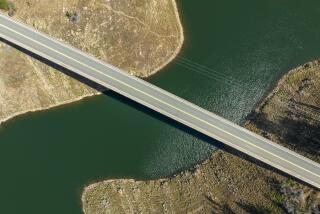Ventura Drought Is Declared Over : Water supply: A National Weather Service meteorologist calls an end to the county’s crisis. But officials elsewhere say it is too early to follow suit.
- Share via
The drought that has ravaged California for the last five years is over in Ventura and southern Santa Barbara counties, a National Weather Service meteorologist declared Monday.
Parts of the two counties already have received as much as 130% of normal rainfall for the year, local reservoirs are approaching pre-drought levels and more rain is expected, said Terry Schaeffer, the National Weather Service meteorologist in Ventura County.
“For all practical purposes, that meets my criteria for the end of the drought. The drought is over,” said Schaeffer, whose Santa Paula office recorded 37 inches of rain during the last 12 months.
Schaeffer’s declaration, one of the first by any official about an end to the drought anywhere in California, came as officials in the city of Santa Barbara said they plan today to declare an official end to the drought there.
His proclamation was greeted cautiously, however, by officials elsewhere who said it is still too early to declare an end to the drought for most areas in the state.
And Pat Rowe, a spokeswoman at the National Weather Service regional office in Los Angeles, said the National Weather Service should leave drought declarations up to local flood control districts and public works departments.
Ventura County Flood Control Department officials conceded that the drought may be over in the county in terms of reservoir levels, but said they would not declare it officially over because of continuing deficits in ground-water supplies.
Other officials in Ventura County said they plan to move slowly in considering any easing of water conservation measures, even if the drought is increasingly considered to be a thing of the past.
One Ventura County city where conservation measures imposed two years ago might be slightly eased is Ventura, said Councilman Tom Buford, a member of the city’s water committee.
He said, however, that it is too early to tell what specific changes might be made to the city’s ordinance, which limits a family of four to 294 gallons of water use per day without penalty.
Other cities in Ventura County, which reported more than an inch of rain in some areas during the latest storm that rolled in Sunday night and continued Monday, said they see no easing of restrictions at this time.
The Calleguas Municipal Water District, which supplies the cities of Simi Valley, Thousand Oaks and Moorpark with nearly all of their water, has not eased restrictions at all because its source is the Metropolitan Water District of Southern California, which gets much of its water from the State Water Project.
Oxnard and Camarillo, which also get water from the MWD, said they too cannot ease water restrictions unless MWD restrictions are eased. Officials in Ojai, which gets its water from local sources, also said they have no plans to ease restrictions.
Officials in other areas of the state were equally cautious about the chances of rolling back conservation measures or declaring an early end to the drought statewide.
“It’s a hopeful sign,” said Maurice Roos, chief hydrologist for the state Department of Water Resources in Sacramento, referring to the effect of the latest series of storms on Ventura and Santa Barbara counties.
“But it took a long time for us to get into the drought and for storage to become so depleted. It will probably take a long time for us to get out of it.”
In Los Angeles County, where rainfall in downtown Los Angeles had reached more than 127% of normal by Monday, residents are still caught in the middle of the drought because of their dependence on water from Northern California, officials said.
Levels at the largest reservoirs in Northern California that supply water for Southern California through the State Water Project are still below 60% of average for this time of year, officials said.
And rainfall statewide is only 75% of normal, said Dean Thompson, specialist at the State Drought Center in the Department of Water Resources.
“It’s ironic that the area of the state that should be out of the drought (Southern California) isn’t because they depend on an outside water source,” he said.
March is traditionally the wettest month throughout the state, and more storms have been predicted for Southern California.
A storm is expected to hit the coast later this week, possibly carrying up to an inch of rain, meteorologist Schaeffer said.
Even without more rainfall, Ventura County’s largest reservoir, Lake Casitas, has already received nearly 30,000 acre-feet of water since the recent series of storms began Feb. 5. That is nearly 1 1/2 times the amount of water that is drawn from the lake each year to serve 55,000 people in the western part of the county.
In Santa Barbara, officials said the City Council is expected today to officially declare the drought emergency over in that city, where a combination of reservoir storage and a new desalination plant guarantee enough supplies to meet demand for at least three years.
The last of Santa Barbara’s drought restrictions, which had residents cutting back by 45% a year ago, is expected to be rescinded today, city officials said.
* RELATED PHOTOS: B1
More to Read
Sign up for Essential California
The most important California stories and recommendations in your inbox every morning.
You may occasionally receive promotional content from the Los Angeles Times.













